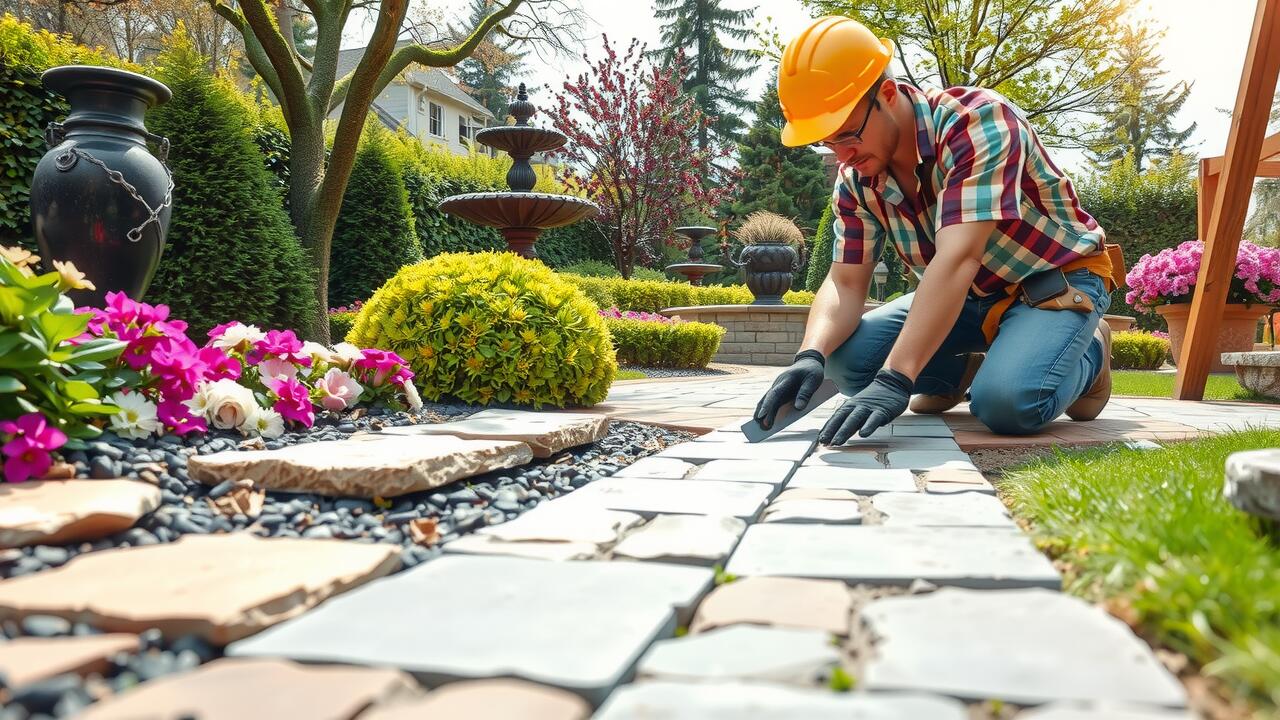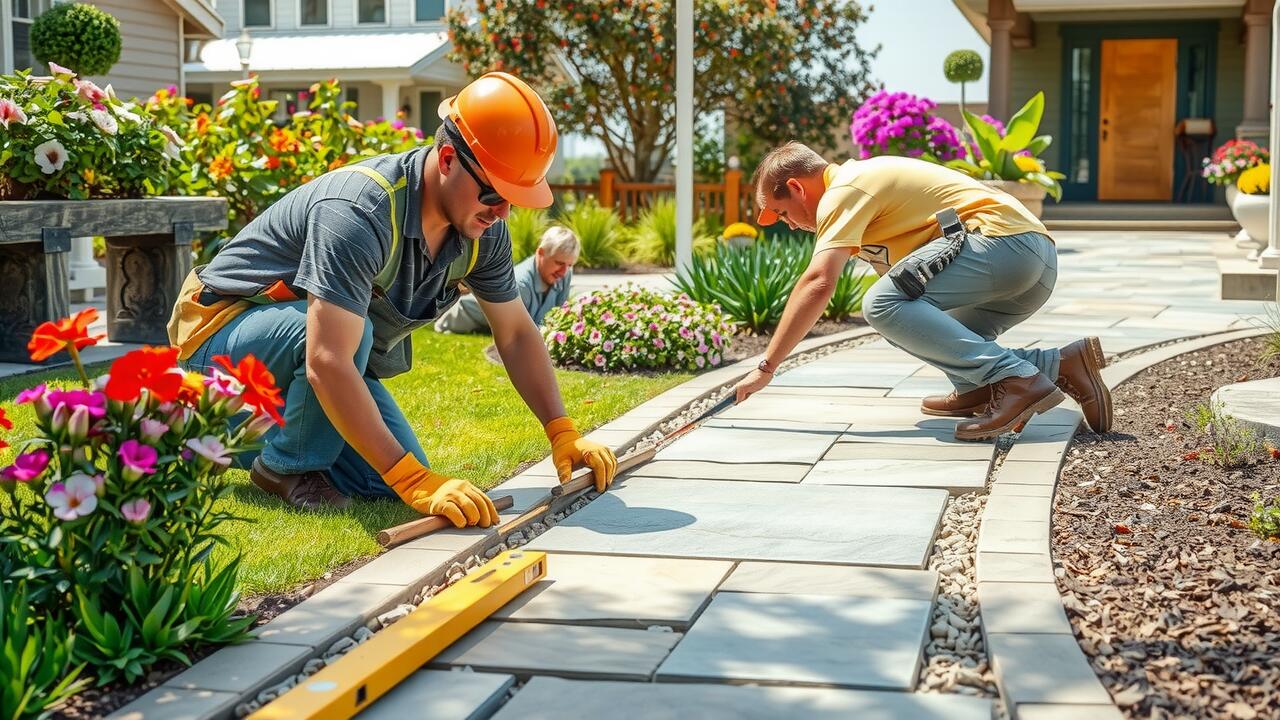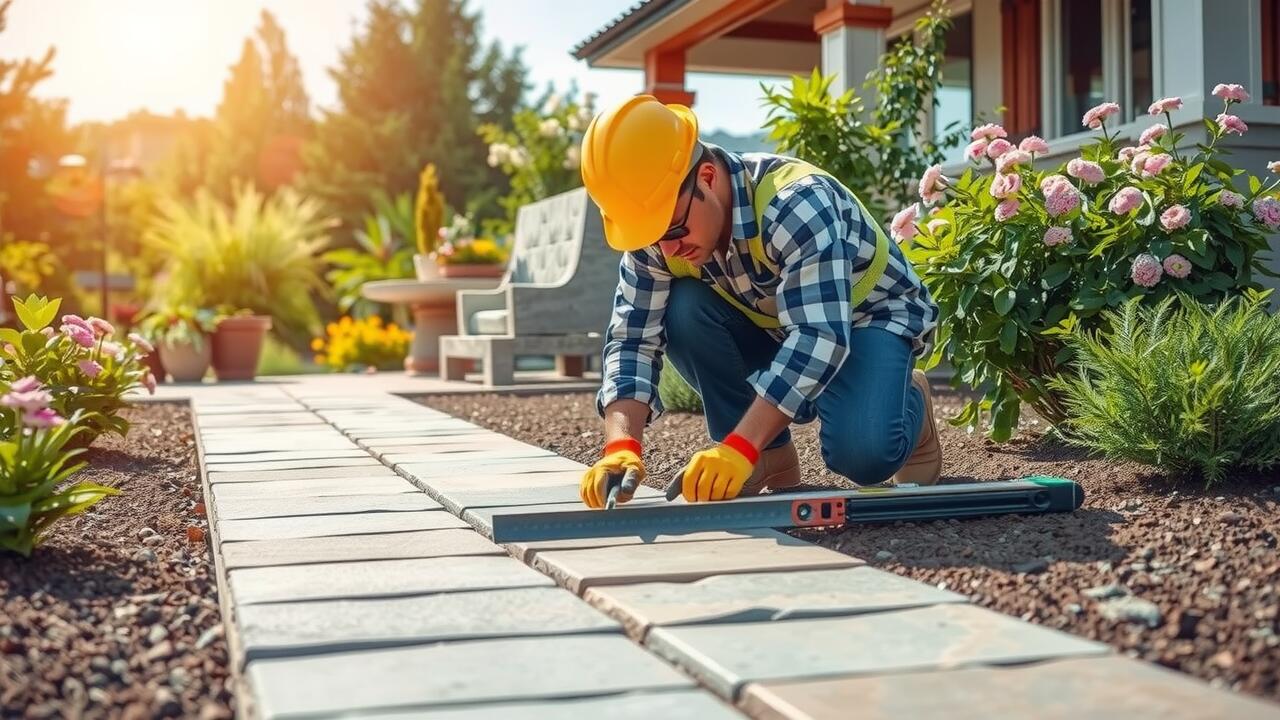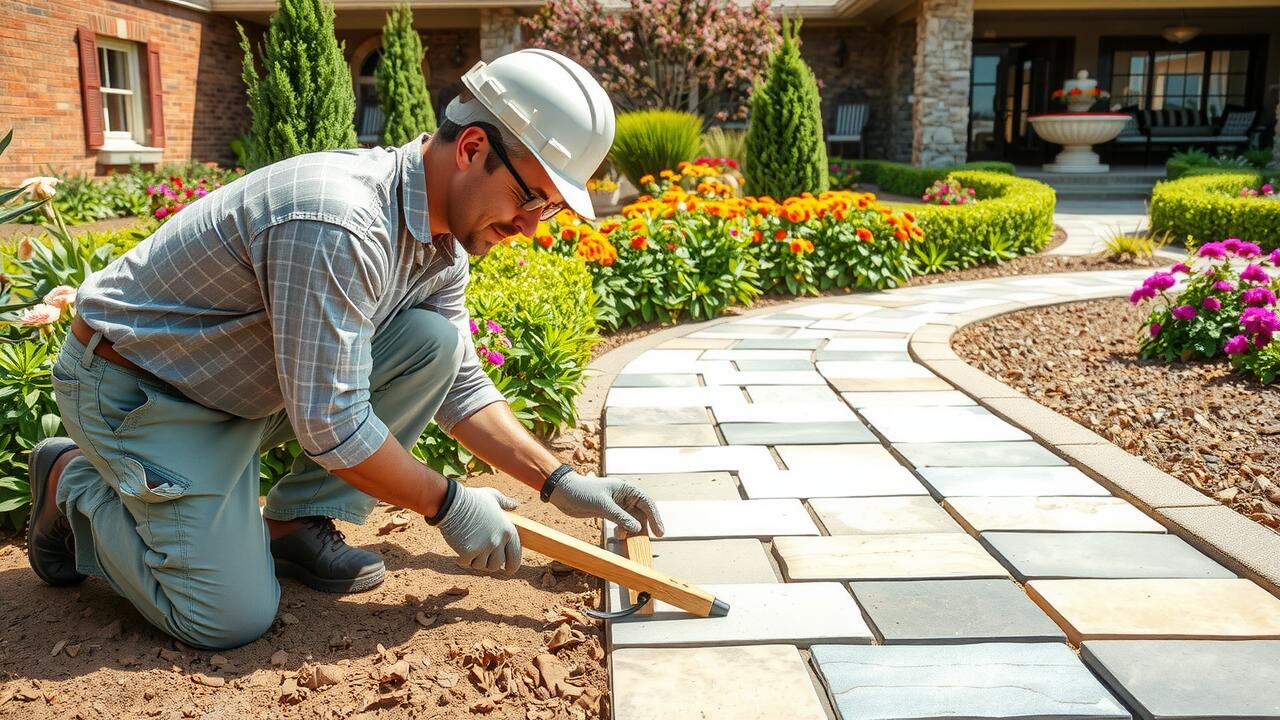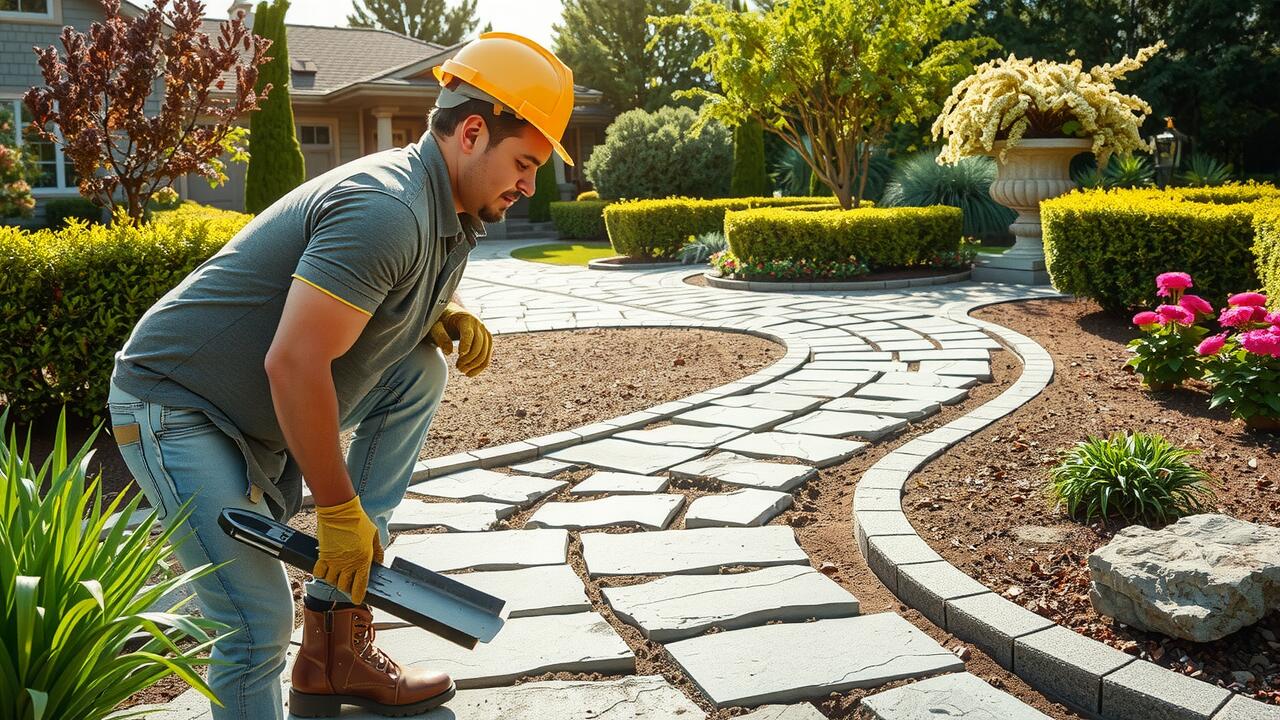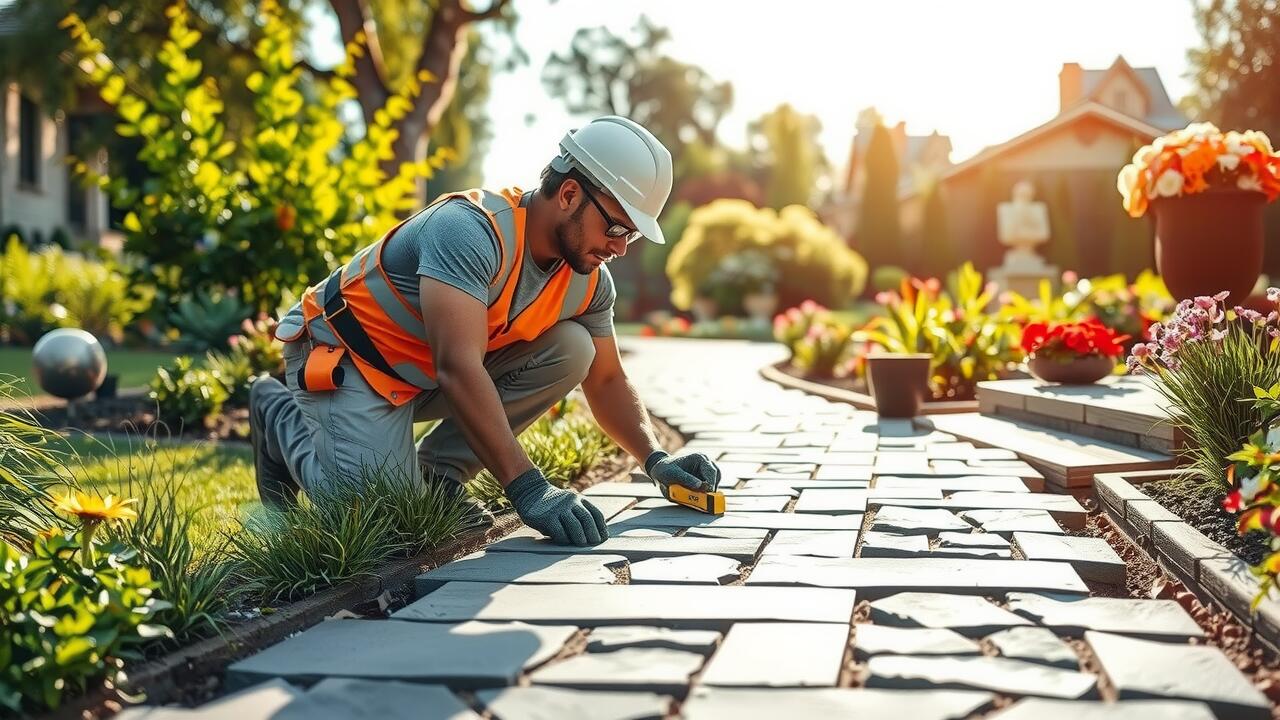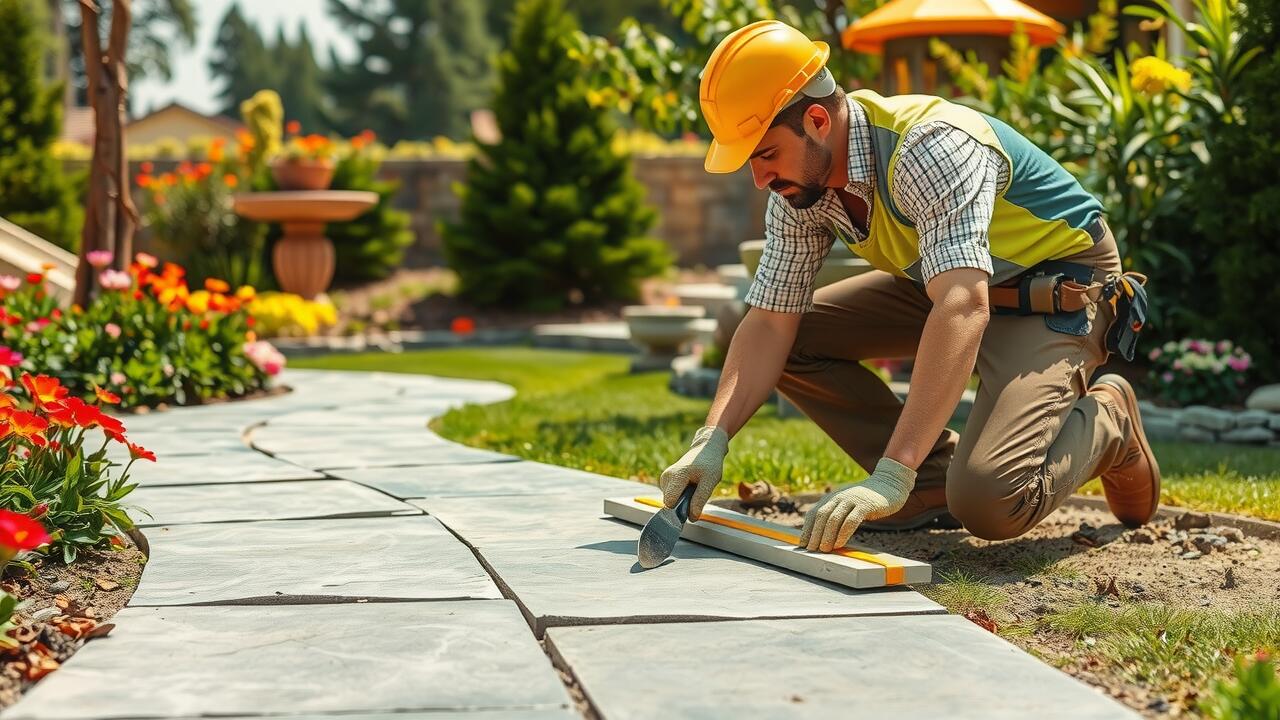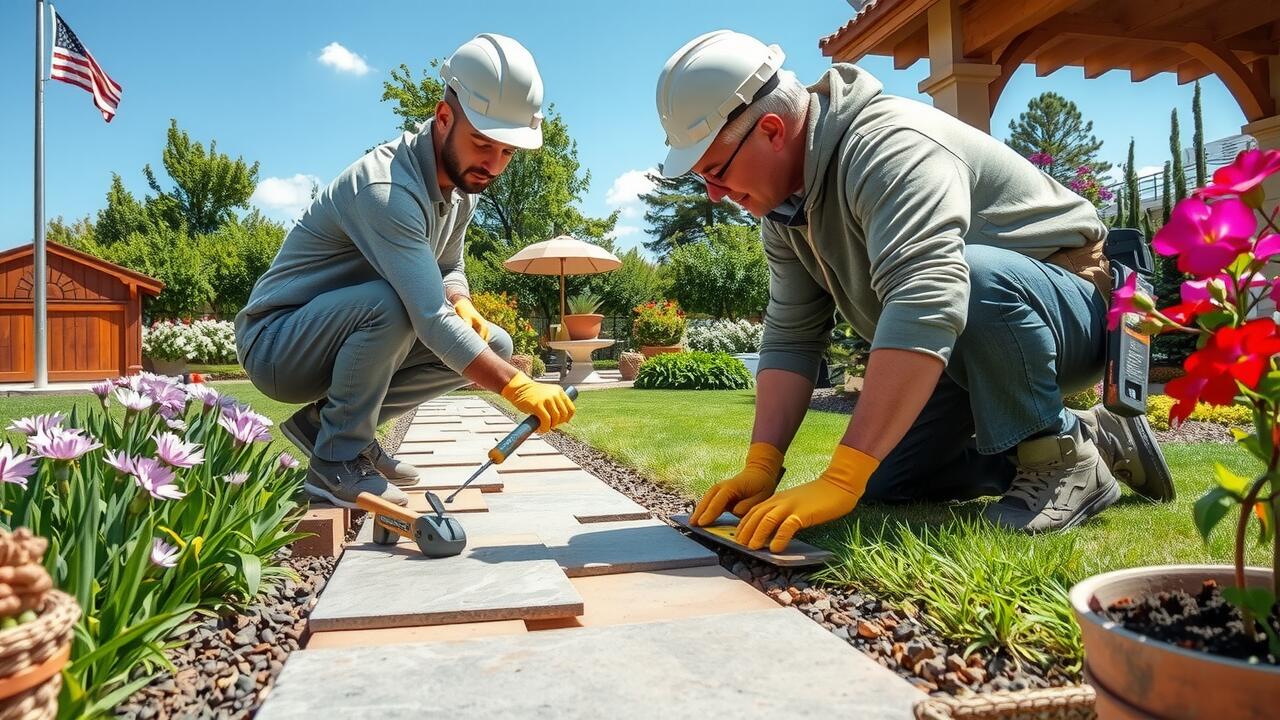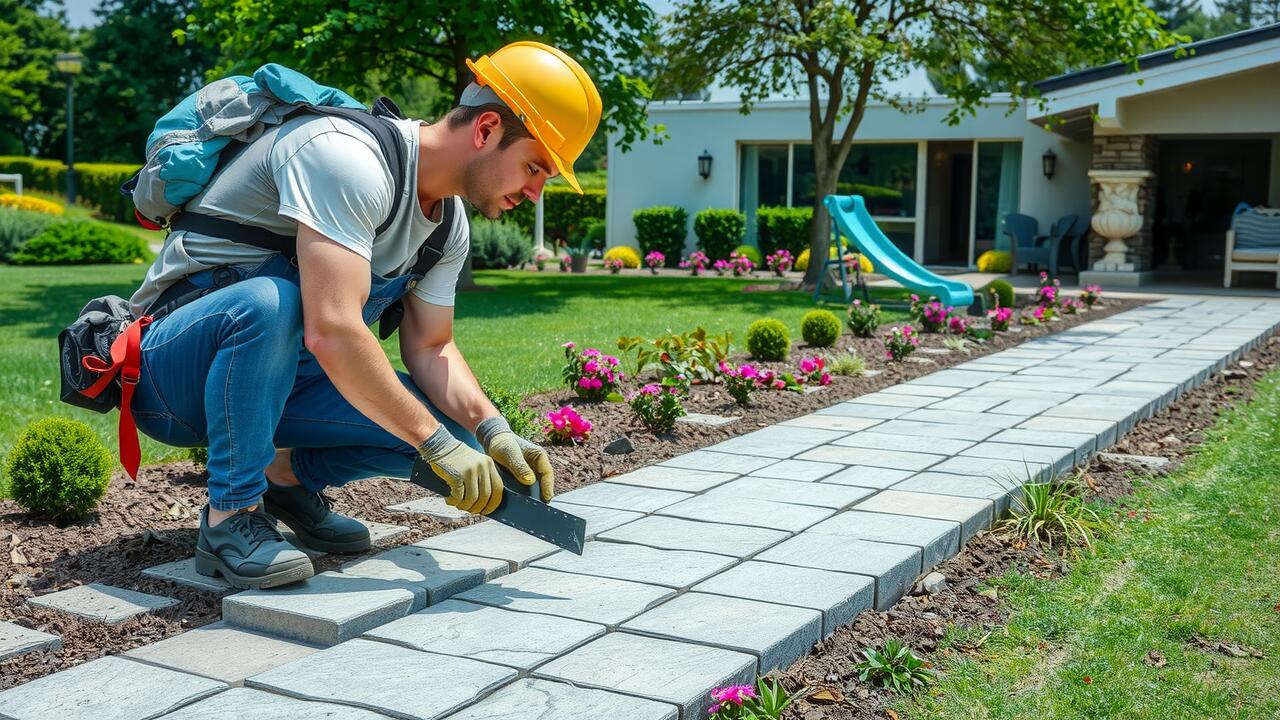Category: Uncategorized
Maintenance Considerations
Maintaining a walkway is crucial to preserving its appearance and functionality. Regular inspections can help identify early signs of wear and tear, such as cracks or uneven surfaces. Weather conditions can affect the longevity of materials used in walkway installation. For example, freezing temperatures can cause certain materials to expand and contract, leading to potential damage over time.
Cleaning is another essential aspect of maintenance. Debris, leaves, and snow can build up and create hazards or contribute to deterioration if left unaddressed. Choosing the right cleaning methods based on the walkway material can enhance longevity. Proper sealing after installation can also provide an added layer of protection against the elements, reducing the frequency and cost of repairs in the future.
Long-Term Care for Walkways
Proper long-term care for walkways ensures they remain a valuable asset to a property. Regular inspections identify any cracks or damages, allowing homeowners to address issues early before they lead to costly repairs. Routine maintenance also includes cleaning the surface to prevent staining and moss growth, which can compromise the walkway’s integrity. Like the initial walkway installation, careful attention to detail during maintenance preserves the overall aesthetic and functionality of the pathway.
Seasonal changes can impact the condition of walkways, making it essential to adapt care practices throughout the year. In winter, measures such as using salt or sand can prevent ice buildup, reducing slip hazards. During periods of heavy rain, monitoring drainage is crucial to avoid erosion around the edges. By investing time and effort into the long-term maintenance of walkways, homeowners can enjoy enduring benefits that enhance both beauty and safety.
Walkways and Property Accessibility
Walkway installation significantly enhances the accessibility of a property, making it easier for residents and guests to navigate the grounds. A well-placed walkway can guide visitors from the street to the front door, eliminating the risk of tripping over uneven terrain or mud. This feature becomes particularly valuable for people with mobility challenges, as it provides a safe route that ensures everyone can engage with the home comfortably.
In addition to the practical benefits, walkways improve the overall flow of the landscape. They can connect various outdoor spaces, such as gardens, patios, and driveways, creating a cohesive environment. By facilitating easy movement throughout the property, walkways enhance the usability of outdoor areas, encouraging more gatherings and activities outside the home.
Improving Functionality for Homeowners
A well-designed walkway can significantly enhance the functionality of a property for homeowners. Walkway installation creates clear paths that guide visitors from entry points to various areas of the home, such as gardens, patios, or garages. This not only improves accessibility but also helps reduce potential wear on lawns or landscaping. A dedicated walkway can facilitate easier movement, especially during inclement weather or when carrying items, providing safety and convenience.
In addition to practicality, walkways can also define outdoor spaces, contributing to better organization of the property layout. They can serve as both a decorative and practical element, offering a structured flow that enhances the overall aesthetic appeal. Homeowners can choose materials and designs that complement their exterior style, allowing for personal expression while maximizing the use of outdoor areas. Walkway installation becomes a key factor in enhancing the livability of a home, encouraging outdoor activities and social gatherings.
Seasonal Considerations
Seasonal changes can significantly impact the condition and usability of walkways. The winter weather, with snow and ice, can create hazards if not properly addressed. Regular maintenance during these months, such as de-icing and snow removal, can help preserve the surface and ensure safety for homeowners and visitors alike. Walkway installation should consider materials that can withstand harsh winters, providing durability and ease of maintenance.
In warmer months, walkways can enhance outdoor activities by providing clear and attractive paths. Proper drainage and attractive landscaping around walkways not only improve aesthetics but also protect the walkway’s integrity against seasonal rains. Homeowners can take advantage of seasonal plantings to integrate walkways into their garden designs. Successful walkway installation emphasizes both practicality and visual appeal, allowing for year-round enjoyment.
Year-Round Value of Walkways
A well-designed walkway offers more than just aesthetic appeal; it enhances the functionality of a property throughout the year. Walkways create clear paths for residents and visitors, promoting safe access regardless of the season. This feature becomes particularly valuable during rainy or snowy months, as it helps prevent mud and snow accumulation near entry points. The convenience provided by a functional walkway can elevate the overall experience of living in a home, making it more appealing to potential buyers.
Walkway installation can significantly impact a home’s value, especially when considering usability and safety. Well-maintained walkways ensure that access points remain clear and navigable year-round, which can enhance both the property’s exterior appeal and its marketability. Homeowners often find that an inviting entrance attracts positive attention, and a thoughtfully laid-out walkway contributes to a welcoming atmosphere. This investment in property infrastructure can yield dividends in terms of both user satisfaction and future resale potential.
FAQS
How much value can a walkway add to my home?
The value a walkway adds to a home can vary based on materials used, design, and local market conditions, but it typically enhances curb appeal and can increase property value by a few thousand dollars.
What types of materials are best for walkways?
Popular materials for walkways include concrete, brick, stone, and pavers. Each offers different aesthetic benefits and durability, so the best choice depends on your home’s style and budget.
Do walkways require a lot of maintenance?
Maintenance needs vary by material; for example, concrete requires occasional sealing, while stone may need weeding and periodic cleaning. Regular care can prolong the life and appearance of your walkway.
Can a walkway improve accessibility for my home?
Yes, a well-constructed walkway can enhance accessibility, making it easier for residents and visitors to navigate your property, especially if you incorporate features like ramps or wide paths.
Is it worth investing in a walkway for my property?
Yes, investing in a walkway can increase your home’s functionality, boost curb appeal, and potentially raise your property’s value, making it a worthwhile addition for many homeowners.
Natural Stone Paths
Natural stone paths offer a timeless aesthetic, enhancing the charm of any garden or outdoor space. These materials provide durability and natural beauty, making them a popular choice for many homeowners. However, the cost of natural stone can be a significant factor in deciding whether to pursue a walkway installation. While investing in high-quality stone can increase the overall value of a property, it’s essential to balance aesthetics with budget constraints.
When considering natural stone for walkway installation, it is useful to explore options that fit different price ranges. Local suppliers often carry a variety of stones, including slate, flagstone, and granite, which may vary in cost depending on availability and demand. Additionally, sourcing stones from nearby quarries or utilizing reclaimed stones can be more economical while maintaining aesthetic appeal. By researching and comparing prices, homeowners can achieve a beautiful pathway without overspending.
Finding Affordable Natural Stone
When considering natural stone for your outdoor path, cost can be a significant factor. One way to save is by sourcing locally. Local quarries or stone yards often offer better prices than big-box retailers. It’s also wise to check for any sales, discounts, or bulk purchase options. Understanding the different types of natural stone available can help in making an informed decision that aligns with your budget as well as your design preferences.
Another approach is to look for remnants or surplus stones from larger projects. Many stone suppliers have leftover materials from previous jobs that they sell at reduced prices. Additionally, exploring options for reclaimed natural stone can provide unique textures and colors while being more economical. Including these stones in your walkway installation not only creates an attractive path but also promotes sustainability by reducing waste.
Recycled Materials for Eco-Friendly Paths
Recycled materials offer an innovative approach to creating eco-friendly paths while also minimizing costs. Using items like old bricks, tiles, or concrete slabs helps to divert waste from landfills and adds a unique character to outdoor spaces. Many communities have local sources where these materials can be acquired at a significantly reduced price. Creative repurposing can also enhance the aesthetic appeal of a garden or yard while supporting sustainable practices.
When considering walkway installation, it’s important to assess the durability and maintenance of recycled options. Stone or brick pathways can last for years, requiring minimal upkeep. Additionally, incorporating other eco-friendly materials, such as crushed glass or reclaimed wood, can create visually striking designs. This approach not only reflects a commitment to environmental stewardship but also promotes individuality in landscaping.
Creative Ideas for Using Repurposed Items
Repurposed items offer a unique and eco-friendly approach to creating outdoor paths. Old bricks, discarded tiles, or even wooden pallets can be creatively transformed into stylish walkways. For example, you can arrange broken concrete pieces in a mosaic pattern for an eye-catching design. This not only makes use of materials that might otherwise go to waste but also provides a one-of-a-kind look that enhances the landscape.
Another imaginative idea involves using wine bottles or glass jars as borders for your path. Placing these along the edges not only helps to define the walkway but also adds a vibrant splash of color. These creative touches can make any walkway installation stand out while being cost-efficient. By incorporating such repurposed materials, you contribute to sustainability while showcasing your personal style in outdoor design.
Using Wood Chips for Walkways
Wood chips provide an affordable and attractive option for creating outdoor walkways. They offer a natural look that blends seamlessly with most landscapes. The installation process is straightforward, making them a popular choice for DIY enthusiasts. For those looking at Walkway Installation, preparing the ground and laying down a layer of wood chips can be quite simple. Proper maintenance, such as replenishing the chips over time, ensures that the pathway remains neat and functional.
In addition to cost efficiency, wood chips are environmentally friendly. They can be sourced from local tree trimming services or landscaping companies, promoting a sustainable approach to walkway solutions. The organic material decomposes naturally, enriching the soil beneath. When considering Walkway Installation, opting for wood chips not only enhances the visual appeal of outdoor spaces but also supports ecological health. This combination makes them a practical choice for homeowners seeking budget-friendly landscaping ideas.
Sustainability and Aesthetic Appeal
Wood chips offer an eco-friendly option for creating visually appealing walkways. They have a natural look and blend seamlessly with outdoor environments, enhancing the overall aesthetics of any garden or yard. The rich, earthy tones of wood chips can complement various landscaping styles. When properly applied, they provide a soft, inviting surface for pedestrians, making the walkway both functional and attractive.
The sustainability aspect of wood chips further elevates their appeal for walkway installation. Sourced from recycled materials, such as tree trimmings and construction waste, they minimize environmental impact while enriching soil when decomposed. This approach not only conserves resources but also promotes a healthier ecosystem. With the right maintenance, wood chip paths can withstand the elements, making them a durable choice for outdoor spaces.
FAQS
What are some of the cheapest materials for outdoor paths?
Some of the cheapest materials for outdoor paths include gravel, mulch, wood chips, and repurposed materials like bricks or stones.
Is natural stone a cost-effective option for outdoor paths?
While natural stone can be more expensive upfront, it is durable and long-lasting, which may make it a worthwhile investment in the long run.
How can I find affordable natural stone for my pathway?
Look for local suppliers, check for seasonal sales, or consider purchasing remnants or surplus stone from construction sites or landscaping companies.
What are some creative ways to use recycled materials for outdoor paths?
You can use old bricks, tiles, or even concrete chunks to create a unique pathway. Pallets can also be transformed into walkways with some creativity.
Are wood chips a good choice for walkways?
Yes, wood chips are an affordable and sustainable option for walkways. They provide a natural look and can improve drainage, but may need to be replenished over time.
Goldfield Ghost Town
A visit to Goldfield Ghost Town offers a captivating glimpse into Arizona’s rich mining history. Established in the late 1800s during a gold rush, this abandoned town has been preserved and transformed into an engaging tourist destination. Guests can stroll through the remnants of old buildings, including the saloon, general store, and church. Each structure tells a story about the people who once lived and worked there, adding a layer of authenticity to the experience.
In addition to the historical sites, Goldfield hosts various events throughout the year, making it a lively spot for visitors. There are opportunities to take guided tours that include gold panning and the iconic narrow-gauge train ride. Local artisans often set up shop, showcasing handcrafted goods that reflect the spirit of the Old West. Scenic views of the surrounding Superstition Mountains provide a striking backdrop, enhancing the overall atmosphere of adventure and exploration.
Goldfield Ghost Town
Canyon Lake
Nestled within the stunning surroundings of the Superstition Mountains, this picturesque lake is a haven for outdoor enthusiasts. Visitors often engage in various recreational activities such as fishing, kayaking, and boating. The lake’s clear blue waters are an inviting backdrop for a day of adventure or relaxation. People’s appreciation for the scenic beauty makes it an ideal spot for photography and sightseeing.
Close proximity to the Tonto National Forest enhances the experience with opportunities for hiking and exploring the dramatic landscapes beyond the water. Picnic areas are available for families looking to enjoy a meal with a view. The area hosts occasional events and guided tours that highlight the rich history and natural beauty of the region, making each visit a unique experience.
Canyon Lake
Saguaro Lake
Surrounded by stunning desert landscapes, Saguaro Lake offers visitors a serene retreat away from the hustle of city life. This picturesque lake is a prime spot for various recreational activities, including fishing, boating, and kayaking. The area is known for its stunning views of the surrounding mountains and the rich wildlife that calls this habitat home. Visitors can enjoy a peaceful day out on the water or choose to hike along the scenic trails nearby, which provide opportunities for photography and wildlife observation.
The Saguaro Lake Marina serves as a convenient starting point for those looking to explore the area while providing boat rentals and supplies. Families can take advantage of picnic areas that overlook the water, creating a perfect setting for a leisurely lunch amid nature. Sunsets here are particularly breathtaking, with the colors reflecting off the water, making it a memorable experience for anyone visiting Apache Junction.
Saguaro Lake
FAQS
What is Goldfield Ghost Town?
Goldfield Ghost Town is a historic site in Apache Junction, Arizona, that features an old mining town, complete with guided tours, shops, and attractions like a mine tour and a zip line.
Are there any activities for families at Apache Junction Public Library?
Yes, the Apache Junction Public Library offers a variety of family-friendly activities, including storytime sessions, educational programs, and community events suitable for children of all ages.
What recreational opportunities are available at Canyon Lake?
Canyon Lake offers various recreational activities such as boating, fishing, hiking, and picnicking, making it a popular destination for outdoor enthusiasts.
Can you swim in Saguaro Lake?
Yes, swimming is permitted at Saguaro Lake, and there are designated areas for swimming, as well as rental facilities for kayaks and paddleboards.
What time of year is best to visit Apache Junction?
The best time to visit Apache Junction is during the fall and spring months when the weather is mild, making outdoor activities more enjoyable.
Permits and Regulations for Walkway Construction
Understanding the local permits and regulations is essential before starting any walkway installation. Many municipalities have specific guidelines that dictate the dimensions, materials, and types of walkways allowed in residential areas. These regulations ensure that the constructed paths adhere to safety standards and enhance the aesthetics of the neighborhood. Failing to obtain the necessary permits can lead to fines or the requirement to remove the walkway, which adds unwanted expenses and project delays.
Consulting with local authorities can provide insights into any restrictions or mandates regarding walkway installation. It may also be beneficial to review any homeowner association guidelines if applicable. Having a clear understanding of what is permitted will streamline the construction process and ensure compliance with local laws. Additionally, staying informed of any zoning regulations can help avoid potential issues later on.
Researching Local Building Codes
Before starting any walkway installation project, it is crucial to research local building codes. These regulations can vary significantly from one municipality to another. They often specify the materials that can be used, the required setbacks from property lines, and construction techniques that must be followed. Understanding these codes can help ensure compliance, minimize legal risks, and avoid costly modifications later in the construction process.
In addition to formal building codes, local zoning laws may influence the design and placement of your walkway. Check if there are any restrictions on walkway dimensions or aesthetic guidelines that need to be adhered to. Engaging with local building authorities early in the planning process can provide additional clarity. This proactive approach ensures that your walkway installation aligns with community standards and regulations.
Designing the Walkway
Designing a walkway requires careful consideration of both aesthetics and functionality. The layout should complement the surrounding landscape and provide ease of movement. Whether opting for a straight path or a more winding design, the shape will influence not only the visual appeal but also how effectively the walkway serves its purpose. Incorporating features like curves can add interest while ensuring it aligns with the overall landscape.
Another critical aspect is the materials chosen for walkway installation. Options vary widely, from natural stone and brick to poured concrete or permeable pavers. Each material offers different benefits, including durability and maintenance requirements. Evaluating the environmental impact of materials is essential as well, particularly for sustainable designs that can withstand local weather conditions without significant wear over time.
Selecting a Suitable Pathway Shape
When selecting a suitable pathway shape for your walkway installation, consider the overall layout of your property. Curved paths can create a more organic feel, adding aesthetic value and guiding visitors gently through the landscape. Conversely, straight paths often convey a more formal appearance and can offer a more direct route from point A to point B. The choice between curved and straight should align with the style of your home and garden, as well as the intended use of the walkway.
In addition to the shape, think about the dimensions of the pathway. Wider walkways tend to be more inviting and practical, especially in spaces where foot traffic is heavy. Narrow paths may work well in smaller areas or gardens, but can feel cramped. The scale of your landscape also plays an important role; a large, expansive yard may benefit from branching paths that explore different areas, while a smaller plot might best be served by a simple, elegant design that enhances the overall flow of the space.
Maintenance Considerations
Regular maintenance is essential for ensuring the longevity and safety of any walkway installation. This includes routine inspections for cracks, uneven surfaces, or any signs of wear that might necessitate repairs. Keeping the walkway clean is also important to prevent the buildup of debris that can lead to slippery conditions. Seasonal maintenance tasks may involve applying sealants and ensuring proper drainage to avoid water damage.
Planning for long-term upkeep involves budgeting for repairs and replacements as needed. Using durable materials in the initial walkway installation can minimize future maintenance needs. Additionally, considering the climate and surrounding landscaping can influence the types of maintenance required. A proactive approach to maintenance can extend the lifespan of the walkway, making it both a functional and aesthetic asset for years to come.
Planning for Long-Term Upkeep
Proper maintenance is crucial for ensuring the longevity of any walkway installation. Regular inspection can help identify issues like cracks or uneven surfaces before they become serious problems. Seasonal care, such as cleaning debris and snow removal, not only improves aesthetics but also maintains safety. While some materials may require little more than a wash, others may need sealing or repairs after years of exposure to the elements.
Investing in quality materials for the walkway installation can minimize the need for extensive upkeep. For instance, choosing durable stone or composite materials can significantly reduce wear and tear. Additionally, selecting plants and landscaping features that complement your walkway can enhance both its function and appeal. With the right choices and attention to detail, long-term upkeep becomes a manageable task rather than a constant concern.
FAQS
What factors should I consider when estimating the cost of a walkway?
Factors to consider include the material type, walkway size, design complexity, labor costs, and any necessary permits or regulations.
How do local building codes affect my walkway estimate?
Local building codes provide regulations that must be followed, which can impact material choices, construction methods, and overall costs. Researching these codes is crucial before beginning your estimate.
What is the importance of choosing the right shape for my walkway?
The shape of your walkway affects not only its visual appeal but also the materials needed and the complexity of the design, which can influence the overall cost estimate.
How can I plan for long-term maintenance costs when estimating a walkway?
To plan for long-term upkeep, consider the durability of materials, required maintenance frequency, and any specific landscaping needs that may arise over time.
Are permits always required for walkway construction?
Not always, but it depends on local regulations. It’s important to check with your local building authority to determine if permits are necessary for your specific walkway project.
Maintenance Tips for Walkways
To keep your walkway in excellent condition, regular maintenance is essential. Clean the surface frequently to prevent the buildup of dirt, leaves, and other debris. This can be easily achieved with a broom or leaf blower. For stone or concrete walkways, a pressure washer can effectively remove stubborn stains and grime. Seasonal checks can help identify cracks or uneven surfaces caused by weather conditions, ensuring any necessary repairs are addressed promptly.
Proper drainage is another key aspect of walkway maintenance. Standing water can lead to erosion and damage over time. Ensure that your walkway installation includes adequate grading to facilitate water runoff. Installing drainage solutions like French drains or gravel beds can help mitigate water-related issues. Regularly inspect the areas around your walkway for any blockages or plant overgrowth that may obstruct proper drainage.
Keeping Your Walkway in Top Shape
Regular maintenance is essential to keep your walkway in top shape. One key aspect is to ensure proper drainage. Standing water can damage the materials used in walkway installation and create safety hazards. Additionally, routine cleaning helps to prevent the buildup of dirt, moss, and debris that can detract from the walkway’s appearance. Using a simple mixture of water and mild detergent can effectively remove stains and algae.
Inspecting the walkway for cracks or loose stones is another important task. Addressing minor issues promptly can prevent them from escalating into larger, more costly repairs. If your walkway was designed with specific materials, be sure to use appropriate repair methods to maintain its integrity. This proactive approach not only preserves the aesthetic appeal but also prolongs the overall lifespan of the installation.
Walkway Trends in Landscape Design
Walkway design has evolved significantly to incorporate various styles and materials that complement modern landscaping trends. Natural stones, such as slate or flagstone, have gained popularity for their organic appearance and durability. Additionally, permeable pavers are emerging as a sustainable option, allowing water to flow through and reducing runoff. Walkway installation now often prioritizes eco-friendliness while still achieving an elegant aesthetic.
Color choices also play a crucial role in contemporary walkway trends. Homeowners are opting for bold hues and textured surfaces to create visual interest. Mixing materials adds a unique flair, with combinations of concrete, wood, and gravel used to form striking pathways. As these trends continue to evolve, walkway installation has become an integral part of landscape design, enhancing both functionality and beauty in outdoor spaces.
Modern Styles and Aesthetic Choices
Modern walkway styles embrace a variety of materials and designs that cater to diverse tastes. Homeowners often opt for natural stone, concrete pavers, or even recycled materials to create unique pathways. Each choice offers different aesthetics and durability levels, allowing for customization that matches the surrounding landscape. The trend of integrating lighting elements into walkway installation enhances safety and adds a visually appealing nighttime atmosphere.
In addition to material selection, geometric patterns and asymmetrical designs are gaining popularity. These modern choices break the monotony of traditional straight paths, adding an artistic flair to outdoor spaces. Incorporating greenery alongside walkways, such as plant borders or ground covers, further enhances the overall look. This fusion of natural elements and modern design principles creates a harmonious blend that elevates the entire landscape.
Choosing the Right Landscaper for Your Project
Selecting the right landscaper for your project can significantly impact the outcome of your walkway installation. It’s essential to look for professionals with experience in hardscape design and a portfolio showcasing previous walkway projects. Consider their knowledge of various materials and styles, as the right choice will enhance both functionality and aesthetics.
In addition to evaluating their previous work, inquire about their process, timeline, and cost estimates. Ask for references from past clients to gain insight into their reliability and professionalism. Understanding a landscaper’s approach to walkway installation will help ensure they meet your expectations and bring your vision to life.
Questions to Ask Before Hiring
When seeking a landscaper for your walkway installation, it’s essential to ask specific questions about their experience and expertise. Inquire about their previous projects, particularly those that involved walkway designs similar to what you envision. Take the time to review their portfolio and check for references. This gives insight into their ability to meet your expectations and deliver quality work.
Understanding the materials and techniques the landscaper plans to use for your walkway installation is just as important. Ask about the pros and cons of different options, including traditional pavers, concrete, or natural stones. Clarifying these details will help you make an informed decision that aligns with both your aesthetic preferences and budget.
FAQS
Do landscapers install walkways?
Yes, many landscapers offer walkway installation services as part of their landscape design and maintenance projects.
What materials do landscapers typically use for walkways?
Landscapers often use a variety of materials for walkways, including concrete, pavers, bricks, gravel, and natural stone, depending on the desired aesthetic and functionality.
How can I maintain my walkway?
To maintain your walkway, regularly clean it by sweeping away debris, remove any weeds, and consider sealing the surface to protect it from the elements, especially if it’s made of stone or concrete.
What are the current trends in walkway design?
Current trends in walkway design include the use of eco-friendly materials, incorporating natural elements, and creating a seamless transition between indoor and outdoor spaces.
How do I choose the right landscaper for my walkway project?
When choosing a landscaper, consider their experience with walkway installations, ask for references or a portfolio of previous work, and inquire about their design process and materials used.
Innovative Composite Materials
Innovative composite materials have revolutionized the walkway installation process. These materials often combine various elements such as polymer resins and natural fibers, resulting in products that are not only durable but also lightweight. The versatility of composites allows for a range of design options, catering to both aesthetic preferences and functionality. Additionally, their resistance to environmental factors makes them suitable for different climates, ensuring longevity and minimal maintenance over time.
The growing popularity of composites in the walkway installation market can be attributed to their sustainable qualities. Many of these materials use recycled components or bio-based resources, thus reducing environmental impact. Furthermore, the ease of installation associated with composites often translates to lower labor costs. As homeowners and contractors seek materials that align with eco-friendly practices, composite options stand out as an enticing choice for modern walkways.
Benefits and Price Range of Composites
Innovative composite materials offer various benefits for walkway installation, merging aesthetics with functionality. Their ability to mimic natural materials while providing enhanced durability makes them an increasingly popular choice. Composites are resistant to fading, moisture, and insect damage, making them ideal for outdoor use. The lightweight nature of these materials simplifies transport and handling, resulting in a more efficient installation process. Additionally, many composites are designed to require minimal maintenance, allowing homeowners to enjoy their walkways without the burden of constant upkeep.
The price range of composite materials varies significantly, reflecting the wide selection available in the market. Generally, these materials can range from moderate to high-cost options, depending on the quality and specific characteristics. Basic composite options may start at competitive prices, while premium versions that offer superior aesthetics and longevity can escalate into the higher price brackets. When considering walkway installation, consumers should assess not only the initial investment but the long-term value these composites offer through their durability and reduced maintenance needs.
The Role of Design in Material Selection
Design plays a crucial role in selecting materials for walkways. The visual appeal and functionality of a walkway often depend on how well the chosen material complements its surroundings. Designers consider factors such as color, texture, and finish when specifying materials. A harmonious design can greatly enhance the overall aesthetic of a space, making the right choice not just about durability but also about creating an inviting atmosphere.
Walkway installation can also be influenced by the complexity of the design. Unique patterns or shapes may require more specialized materials or installation techniques, which can increase costs. Additionally, the environmental conditions and intended use of the walkway can dictate material selection. Designers must weigh the trade-offs between aesthetics and practicality, ensuring that chosen materials align with the project’s vision while also considering maintenance and longevity.
How Design Choices Affect Material Costs
Design choices play a crucial role in determining the overall cost of walkway installation. Factors such as the complexity of the layout, custom shapes, and the selection of complementary features can significantly impact expenses. A simple, straight walkway may use fewer materials and require less labor, while intricate designs featuring curves and patterns demand more precise engineering and craftsmanship. Additionally, the choice of color and texture can lead to variations in pricing, influencing both material selection and installation techniques.
Furthermore, aesthetic elements like borders, insets, or integrated lighting can enhance the visual appeal but also add to the overall cost. These design features not only require more materials but also skilled labor to ensure a flawless execution. Ultimately, the aesthetics and functionality desired in the walkway design will dictate the choice of materials and their associated costs, making it essential for homeowners to balance their vision with their budget during the planning phase.
Maintenance Costs of Premium Walkway Materials
When considering premium materials for walkways, maintenance costs often play a significant role in the overall investment. High-end materials such as natural stone or composite options may be more durable, reducing the frequency of repairs and replacements. However, some desirable materials may require specific cleaning agents or sealants, leading to additional recurring expenses. Homeowners should weigh these ongoing costs against the initial price of walkway installation and the longevity of the chosen material.
Additionally, seasonal weather can impact maintenance needs. For instance, materials like wood may need regular treatment to prevent decay, while certain composites can withstand the elements more effectively. Understanding the long-term benefits of investing in premium materials involves calculating not only the upfront costs but also the future expenses associated with upkeep. Choosing the right material can ultimately enhance the overall value of the property while providing a beautiful and functional walkway.
Long-Term Investment vs. Upfront Costs
When considering materials for a walkway, it’s essential to weigh the long-term investment against initial costs. Premium materials often present a higher upfront price, reflecting their superior durability, aesthetic appeal, and low maintenance requirements. For example, natural stone or high-end composites may have a steep installation price. However, their lifespan can far exceed that of more economical options, leading to lower replacement costs over time.
Walkway installation using high-quality materials can be viewed as an investment in the property itself. Homeowners may find that lasting materials enhance curb appeal and increase property value. The lower maintenance costs associated with premium materials contribute further to this equation, as they often require less frequent repairs or replacements. Balancing these factors can help make an informed decision that aligns with both budget constraints and long-term goals.
FAQS
What are some examples of the most expensive materials for a walkway?
Some of the most expensive materials for a walkway include natural stone such as granite and marble, high-quality composites, and specialized materials like porcelain or glass pavers.
How do innovative composite materials compare to natural stone in terms of cost?
Innovative composite materials can be more affordable than natural stone while still offering durability and aesthetic appeal. However, high-end composites can also reach similar price points as premium natural stones.
What factors influence the cost of walkway materials?
The cost of walkway materials is influenced by factors such as material type, design complexity, installation requirements, and geographical location, as labor and material availability can vary.
Are maintenance costs for expensive walkway materials worth it?
While maintenance costs can be higher for premium materials, they often provide longevity and aesthetic value that may justify the initial investment, making them worthwhile in the long run.
How can design choices impact the overall cost of a walkway?
Design choices can significantly impact costs through factors like the complexity of the layout, the choice of materials, and the need for custom installations, which can all increase both material and labor expenses.
Permits and Regulations
Before beginning any walkway installation project, it’s essential to understand and comply with local permits and regulations. Many municipalities require homeowners to obtain a permit for sidewalk construction, especially if it affects public property or right-of-way. Failure to secure the necessary approvals could lead to fines or complications down the line. Researching your local government’s requirements can clarify which permits are necessary and any specific guidelines you must follow during the installation process.
Navigating these regulatory requirements can sometimes be challenging due to variations in local laws. Some areas may have restrictions on materials, dimensions, or even the design of the sidewalk. Understanding these regulations not only ensures compliance but can also influence the overall cost and design of your walkway. Consulting with local planning departments or access official websites can provide valuable information and streamline your walkway installation efforts.
Navigating Local Requirements
Before starting any walkway installation project, it is essential to familiarize yourself with local permits and regulations. Municipalities often have specific guidelines regarding the width, material, and placement of sidewalks. This ensures that walkways are safe and accessible for all pedestrians. Check with your local city or county planning department to understand the necessary paperwork and compliance standards. Failure to secure proper permits can lead to fines or require costly rework down the line.
In addition to permits, consider the zoning laws that may affect your walkway installation. These regulations can dictate where sidewalks can be placed, particularly if your property borders public spaces. Understanding setbacks and easements is crucial to avoid conflicts with utilities and neighboring properties. Engaging with local community boards or neighborhood associations may provide insight into the best practices for sidewalk construction in your area.
Choosing the Right Location
Selecting the right location for your sidewalk is crucial for ensuring its functionality and accessibility. Consider areas with high foot traffic, such as near entrances to homes, businesses, or parks. Additionally, evaluate existing pathways and nearby utility lines to prevent any disruptions during the walkway installation process. An ideal location should not only connect key destinations but also comply with local regulations regarding distance from property lines and other structures.
Accessibility is also an important factor while choosing the location. Ensure that the sidewalk is easily navigable for pedestrians of all ages and abilities. Gentle slopes can help accommodate wheelchair users, while materials that provide traction can prevent slips and falls. By strategically planning the layout, you can enhance safety and usability, making the walkway installation a valuable addition to the community infrastructure.
Factors to Consider for Accessibility
When planning a sidewalk, accessibility should be a top priority to ensure that everyone can use the pathway comfortably. Consider the width of the sidewalk; a minimum of 36 inches is recommended to allow for easy passage. This width can accommodate wheelchairs, strollers, and pedestrians walking side by side. Additionally, slopes and cross slopes must be minimal to facilitate safe navigation for individuals with mobility challenges. Ensuring smooth transitions at driveways and curb cuts can significantly enhance accessibility in the design.
Another crucial aspect of accessibility during walkway installation is the surface material chosen. Opt for non-slip surfaces to minimize hazards, especially in wet conditions. Textured materials can provide guidance for visually impaired individuals, offering more independence when navigating the area. Pay attention to the placement of any obstacles, such as benches or signs, that could interfere with traffic flow. All these considerations contribute not only to usability but also to the overall safety and comfort of all sidewalk users.
Sustainable Options for Sidewalks
Many homeowners are increasingly considering sustainable options for sidewalks that not only reduce environmental impact but also align with budget limitations. Recycled materials are gaining popularity, with options like reclaimed bricks or permeable pavers. These choices allow for effective drainage, easing water runoff and minimizing the risk of flooding. By selecting eco-friendly materials, individuals can contribute to local sustainability efforts while maintaining a functional and attractive pathway.
Another avenue for sustainable walkway installation involves using porous concrete or asphalt. These materials allow rainwater to seep through, significantly reducing stormwater runoff and promoting groundwater recharge. Additionally, investing in solar-powered lights for nighttime visibility can enhance safety along the path without increasing electricity consumption. Overall, conscious choices in materials and design can lead to both cost savings and lasting benefits for the environment.
Eco-Friendly Materials and Their Costs
Eco-friendly materials have gained traction in sidewalk construction due to their sustainability and long-term benefits. Recycled concrete is a popular choice, as it repurposes materials from demolition sites, reducing waste and minimizing the carbon footprint associated with traditional concrete production. Porous paving stones also promote water drainage and reduce runoff, encouraging better environmental practices. Both options are not only eco-conscious but also cost-effective for those seeking budget-friendly walkway installation.
The costs associated with eco-friendly materials can vary widely based on local availability and select supplier pricing. While some recycled materials may be cheaper upfront, it’s essential to consider the longevity and maintenance costs over time. Choosing sustainably sourced gravel or permeable pavers might require a higher initial investment, but they can lead to substantial savings through durability and reduced environmental impact. By evaluating the long-term benefits against the initial expenditures, homeowners can make informed decisions regarding their sidewalk projects.
FAQS
What is the average cost of installing a sidewalk?
The average cost of installing a sidewalk can vary widely depending on materials, location, and labor costs, but it typically ranges from $5 to $15 per square foot.
Do I need a permit to install a sidewalk?
Yes, in most cases, you will need to obtain a permit before installing a sidewalk. It’s important to check with your local government to understand specific regulations and requirements.
What eco-friendly materials can I use for a sidewalk?
Eco-friendly materials for sidewalks include permeable pavers, recycled concrete, and stabilized decomposed granite. These options are often more sustainable and can reduce stormwater runoff.
How do I choose the right location for my sidewalk?
When choosing the right location for a sidewalk, consider factors like accessibility, proximity to existing paths, and the natural flow of foot traffic to ensure it meets the needs of pedestrians.
Are there any low-cost alternatives to traditional concrete sidewalks?
Yes, alternatives such as gravel, wood chips, or mulch can be more affordable options for creating a walking path, although they may require more maintenance over time compared to concrete.
Aesthetic Value of Concrete Versus Pavers
The aesthetic value of concrete and pavers can greatly influence the choice between the two for various landscaping projects. Concrete offers a clean, uniform appearance that can enhance modern designs. Its versatility allows for different finishing techniques, such as stamping and coloring, which can mimic natural stones or create unique patterns. For walkway installation, a smooth concrete finish provides a sleek, contemporary look that is easy to maintain.
On the other hand, pavers bring a more natural and textured aesthetic to outdoor spaces. They come in various colors, shapes, and sizes, allowing for creative designs and patterns that can enhance the overall landscape. The irregular shapes and seams of pavers create a charming, rustic feel that many homeowners find appealing. During walkway installation, pavers can be arranged in intricate layouts, providing both visual interest and functionality.
Design Options Available
When considering design options for walkway installation, both concrete and pavers offer a variety of choices that can enhance the visual appeal of any outdoor space. Concrete can be stamped, stained, or textured to imitate the look of stone or wood, allowing for customization in patterns and colors. This flexibility enables homeowners to create unique designs tailored to their aesthetic preferences.
In contrast, pavers are available in numerous shapes, sizes, and colors, providing an additional level of artistic expression. The ability to mix and match different types of pavers allows for intricate patterns that can complement surrounding landscapes. This versatility makes pavers a popular choice for those looking to achieve a more decorative and personalized walkway installation while still ensuring durability and functionality.
Longevity of Concrete and Pavers
The longevity of concrete and pavers can vary significantly based on the quality of materials and installation practices. Concrete typically has a lifespan of 30 to 40 years when properly installed and maintained. It is highly durable and can withstand heavy loads, making it a practical choice for high-traffic areas. With proper sealing and regular maintenance, concrete surfaces can resist cracking and weathering over time.
Pavers, on the other hand, are often expected to last over 25 years, but their longevity largely depends on the base material and installation quality. They have the advantage of being easier to replace individually if damage occurs, which can extend the overall lifespan of a walkway installation. The flexibility of pavers allows for natural movement without cracking, as they can shift with the ground beneath them. This feature makes pavers a resilient option for outdoor spaces subject to changing conditions.
Expected Lifespan and Performance
When considering walkway installation, the expected lifespan of concrete is typically between 25 to 30 years. This durability arises from its resistance to weather elements and heavy loads. While cracks can occur over time, proper installation and maintenance can significantly extend its life. Concrete also performs well under high traffic, making it a favored choice for commercial applications or busy residential areas.
Pavers, on the other hand, often provide an appealing alternative with an expected lifespan ranging from 20 to 30 years. Their interlocking design allows for flexibility, which can lead to less cracking compared to concrete. Proper installation is crucial for paver performance; settling and shifting may occur if the base is inadequate. Regular maintenance, including the occasional replacement of individual stones, can also help sustain the aesthetics and functionality of a paver walkway.
Environmental Impact of Concrete and Pavers
The environmental impact of concrete and pavers varies significantly, especially when considering the materials used in their production. Concrete production is known for its high carbon footprint, primarily due to the cement manufacturing process, which releases substantial greenhouse gases. In contrast, pavers can be made from a variety of materials, including recycled options, which may reduce their overall environmental impact. The production methods and materials chosen can greatly influence the sustainability of both options.
Walkway installation using pavers typically allows for better water drainage compared to solid concrete surfaces. This permeability leads to lesser runoff and helps replenish groundwater, benefiting local ecosystems. Additionally, pavers can provide a more natural aesthetic, promoting biodiversity by allowing soil and plants to thrive in the spaces between them. In contrast, concrete surfaces often contribute to urban heat islands, exacerbating heat-related issues in densely populated areas.
Sustainability and Eco-friendliness
Concrete production involves significant energy consumption and greenhouse gas emissions, raising concerns about its sustainability. This process contributes to the carbon footprint associated with material production. In contrast, many pavers are made from natural stone or recycled materials, which can reduce environmental impact. Choosing permeable paver options allows for better rainwater management, promoting groundwater recharge and minimizing surface runoff.
Walkway installation with pavers can offer an eco-friendlier solution compared to traditional concrete. The use of sustainable materials often correlates with reduced environmental degradation. Additionally, pavers can be repaired easily without needing to replace the entire surface, promoting longevity and less waste. As consumers become more conscious of environmental issues, sustainably sourced pavers are increasingly appealing for outdoor projects.
FAQS
What factors determine the cost of laying concrete versus pavers?
The cost can be influenced by materials, labor, design complexity, and the preparation of the site. Concrete is generally less expensive initially, but pavers offer more design options which can affect overall pricing.
Are concrete or pavers more durable?
Concrete typically has a longer lifespan and can withstand heavy loads better than pavers. However, pavers can be replaced individually if damaged, which may be more cost-effective in the long run.
How do maintenance costs compare between concrete and pavers?
Concrete often requires less maintenance, needing only occasional sealing and repairs, while pavers may need more frequent joint maintenance and weed control, which can add to the cost over time.
Can I install concrete or pavers myself to save money?
Both options can be installed as DIY projects, but concrete pouring requires specific skills to ensure a flat finish, whereas paver installation is generally more straightforward and accessible for beginners.
What are the environmental considerations for choosing concrete versus pavers?
Pavers tend to be more environmentally friendly as they allow for better drainage and can incorporate recycled materials. Concrete production has a higher carbon footprint, but some eco-friendly concrete options are also available.
Seasonal Pricing Variations
Seasonal pricing variations can greatly influence the overall cost of walkway installation. Many contractors experience peak seasons during spring and early summer when demand for outdoor projects rises. During these months, homeowners may find that labor costs increase due to higher demand, leading to more competitive pricing among contractors. On the other hand, fall and winter often see a decline in demand, which may result in discounted rates for installation.
Weather conditions also play a role in pricing strategies throughout the year. In regions where winter weather can halt work, contractors may offer lower prices during the off-season to secure projects ahead of time. This can be an advantage for homeowners looking to save on installation costs. Understanding these seasonal fluctuations can help in planning the timing of a walkway installation while maximizing budget efficiency.
When Is the Best Time to Install a Walkway?
Timing is crucial when considering walkway installation. Late spring and early fall often provide ideal weather conditions for such projects. Temperatures are generally mild, which allows for more manageable working conditions. Additionally, soil preparation becomes easier during these seasons, as the ground is usually not too wet or frozen.
Homeowners should also consider local climate patterns. In areas with heavy snowfall, planning for installation before winter can prevent complications with both the project and subsequent maintenance. Installing a walkway during the appropriate season can enhance the durability and aesthetic appeal of the finished product.
Maintenance Costs After Installation
After your walkway installation is complete, it’s essential to consider the ongoing maintenance costs that will arise. For most materials, regular upkeep is required to ensure durability and appearance. For example, concrete walkways may need sealing every couple of years, while paver walkways may require occasional re-sanding of the joints to prevent weed growth. Regular cleaning is also important to remove dirt, leaves, and other debris that can accumulate over time, potentially costing additional time and effort.
Different materials will naturally incur different maintenance expenses. Natural stone and pavers might require more attention to prevent moss and weed growth, leading to higher long-term costs. In contrast, a simple gravel walkway may need periodic replenishing of gravel to maintain its appearance and stability. Homeowners should budget for these ongoing costs to maintain the integrity and aesthetics of their walkway installation.
Long-term Upkeep for Different Materials
The longevity of a walkway largely depends on the materials chosen during its installation. Concrete walkways are known for their durability and require minimal maintenance over the years. Regular sealing can enhance their lifespan and protect against cracking. Paver walkways, while aesthetically appealing, may need occasional resetting as shifting can occur over time. It’s essential for homeowners to understand that the initial choices during the walkway installation significantly influence future upkeep efforts and costs.
Natural stone walkways offer a unique charm and can last for decades with proper care. However, they may require more frequent cleaning and resealing than other materials to maintain their appearance. Asphalt walkways are another option, boasting affordability and a relatively straightforward maintenance process. They require sealing every few years, which is crucial for preventing deterioration. By considering these factors, homeowners can make informed decisions about the long-term upkeep involved in their walkway installation.
Budgeting for Unexpected Expenses
When planning a walkway installation, it’s crucial to account for unexpected expenses that may arise during the project. Factors such as unforeseen site conditions, weather-related delays, or the need for additional materials can quickly increase costs. Having a well-thought-out budget that includes a contingency fund can help alleviate stress if these issues occur. Setting aside 10 to 20 percent of the total estimated project cost as a buffer is a common recommendation.
In addition to hidden costs, changes in design or materials after the project has begun can also lead to budget overruns. If you decide to upgrade the quality of materials or add features like lighting or landscaping, these adjustments should be carefully considered beforehand. Being prepared for fluctuations in costs will enable homeowners to manage their finances more effectively and ensure the walkway installation meets all expectations without breaking the bank.
Contingency Plans for Walkway Projects
When planning for walkway installation, it is essential to set aside a budget for unexpected expenses. These could arise from various issues, such as the discovery of underground utilities or soil instability. Including a contingency fee of around 10-20% of the total project cost can provide a safety net, ensuring you have the funds necessary to tackle any surprises that may occur during construction.
Proper planning also involves considering alternative solutions if problems arise. For instance, if the originally chosen materials become unavailable, having a backup selection can prevent delays. This flexibility can make a significant difference in maintaining the project’s timeline and keeping costs under control while ensuring that your walkway installation meets your expectations.
FAQS
What factors influence the cost of building a walkway?
Several factors influence the cost of building a walkway, including the materials used, the size and design of the walkway, labor costs, and any additional features such as lighting or landscaping.
How can I save money on my walkway installation?
To save money on walkway installation, you can consider using more affordable materials, doing some of the work yourself, or scheduling the installation during off-peak seasons when labor costs may be lower.
Are there different costs associated with various materials for walkways?
Yes, different materials vary significantly in cost. For example, gravel and concrete are generally less expensive options, while natural stone or custom pavers can be more costly.
What maintenance costs should I expect after installing a walkway?
Maintenance costs can vary depending on the material. For example, wood may require regular sealing and staining, while concrete might need occasional cleaning and resealing. Budgeting for these costs is important for long-term upkeep.
How can I prepare for unexpected expenses during a walkway project?
It’s advisable to create a contingency plan by setting aside a percentage of your total budget—typically around 10-15%—to cover any unexpected issues that may arise during the installation process.
Paver Installation
Paver installation offers a durable and visually appealing option for creating walkways. The process begins with careful planning and preparation, which includes measuring the area and selecting the appropriate materials. Proper ground preparation is crucial. It often involves clearing the area, leveling the ground, and laying a sturdy base to ensure a stable foundation for the pavers.
Once the base is in place, the actual walkway installation can begin. Pavers come in various shapes, sizes, and colors, allowing for a range of design options to suit any landscape. For DIY enthusiasts, this type of project can be manageable with a little effort and the right tools. Following proper installation techniques ensures longevity, minimizing the need for repairs or replacements in the future.
Choosing Inexpensive Paver Types
When it comes to selecting pavers for your walkway installation, affordability plays a key role. Consider options such as concrete, which is often more economical than natural stone. Interlocking concrete pavers come in various styles and colors, allowing for creative designs while keeping costs low. Another option is using brick pavers, which can sometimes be found at discounted prices, especially if purchased in bulk or through local suppliers.
Recycled materials also offer a budget-friendly alternative to traditional pavers. Keep an eye out for surplus pavers or overstock from construction sites. These materials can reduce both your expenses and environmental impact. Additionally, exploring options like porous pavers can be beneficial as they allow for water drainage, promoting sustainability without breaking the bank during walkway installation.
Recycled Materials for Walkways
Using recycled materials for walkways can significantly reduce costs while adding unique character to your outdoor space. Many homeowners turn to reclaimed stone and brick, which not only come at a lower price but also contribute to an eco-friendly approach. These materials often have a weathered appearance that adds charm. When considering walkway installation, opting for recycled materials can make a substantial difference in your budget without sacrificing aesthetics.
Creative uses for reclaimed materials can also enhance the overall design of your walkway. For instance, old bricks can be arranged in various patterns, creating visual interest and personalization. Stone pavers can be combined with smaller gravel or mulch for a rustic feel. Incorporating these elements during walkway installation not only saves money but also promotes sustainability, giving a second life to materials that might otherwise end up in a landfill.
Creative Uses for Reclaimed Stone and Brick
Reclaimed stone and brick provide a unique option for those interested in creating a budget-friendly walkway. These materials often carry character and history that newer options lack, making them an attractive choice for homeowners looking to enhance their outdoor space. Walkway installation using reclaimed materials not only reduces waste but also allows individuals to incorporate a variety of textures and colors, giving each project a distinctive appearance.
Using reclaimed materials can also lead to significant cost savings. Many salvage yards or local businesses offer bricks and stones at a fraction of the cost of new materials. By selecting bricks of varying sizes and stones with different finishes, homeowners can create visually striking patterns while keeping expenses low. This approach not only enhances the walkway’s aesthetic appeal but also contributes to an eco-friendly outdoor environment.
The Role of Landscaping in Walkway Costs
Landscaping plays a significant role in determining the overall cost of walkway installation. The type and extent of landscaping can enhance the visual appeal of a walkway while also affecting labor and material costs. Simple ground covers or native plants may help keep expenses low, while intricate garden designs and exotic plant selections can increase the budget considerably. Careful planning and selection of materials are essential to achieve both aesthetic and financial goals.
Incorporating plants strategically along the walkway can not only beautify the space but also create a cohesive look. Using low-maintenance, drought-resistant plants can minimize upkeep costs. Furthermore, the placement of trees or bushes may provide natural shade, which can extend the life of walkway materials and lessen maintenance needs. Thoughtful landscaping choices can ultimately contribute to a more cost-effective walkway installation.
Incorporating Plants to Enhance Value
Incorporating plants around your walkway not only enhances its visual appeal but can also add functionality. Strategically placed flowers, shrubs, and ground cover plants can create a vibrant environment that complements the hardscape. For instance, colorful perennials or low-maintenance succulents provide aesthetic value without demanding extensive upkeep. This allows for a more inviting entrance or pathway, making the area feel more integrated with the surrounding landscape.
When planning your walkway installation, consider the types of plants that thrive in your local climate and the amount of sunlight the area receives. Native plants are often ideal because they require less water and care while supporting local wildlife. By selecting appropriate flora, you can enhance the walkway’s attractiveness and create a harmonious balance between nature and the pathway, leading to increased overall satisfaction with your outdoor space.
FAQS
What materials are the cheapest for making a walkway?
The cheapest materials for making a walkway typically include concrete pavers, gravel, or recycled stones and bricks. These options can minimize costs while still providing a durable surface.
How can I use recycled materials to save money on my walkway?
You can use reclaimed bricks, stones, or even broken concrete to create a unique and cost-effective walkway. These materials can often be found at local construction sites, recycling centers, or through community exchanges.
What is the most affordable way to install a walkway?
The most affordable way to install a walkway is to do it yourself. This avoids labor costs associated with hiring professionals. You can follow online tutorials for guidance on installation techniques.
How can landscaping affect the overall cost of my walkway?
Landscaping can increase the overall cost due to the need for plants, mulch, or soil. However, incorporating low-maintenance plants or native species can enhance the walkway’s aesthetics without significantly driving up costs.
Are there any inexpensive design tips for walkways?
Yes! Incorporating simple designs, such as a straight path or a staggered paver layout, can save on material costs. Additionally, using plants along the edges can enhance visual appeal without requiring expensive materials.

